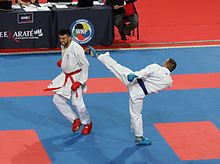Mawashi-geri
The Mawashi-Geri ( Japanese 回 し 蹴 り , "rotating kick") is a semicircular kick in the Japanese martial arts ( Budō ), especially in karate .
The Mawashi-Geri is not one of the "classic" kicks in martial arts. It is believed that it came into widespread use only after karate became popular in Japan. An indication of this is the fact that Mawashi-geri is not used in any old kata .
In competition practice, the Mawashi-Geri serves as an effective attack technique. In contrast to Mae-Geri or Ushiro-Geri, it is not a direct technique, but rather it reaches the goal via a detour. Therefore, this kick is a good choice in competition, especially when trying to bypass strong cover.
In self-defense, the Mawashi-Geri is initially used less often as a defensive technique. Yoko-Geri or Mae-Geri offer an immediate stop function here. With a short distance it can also be useful to give preference to the Mawashi-Geri.
species
There are the following types of Mawashi-Geri:
-
Mawashi-Geri
In Kihon , this kick is practiced from the Heisoku-dachi or from Zenkutsu-dachi, depending on the style . In Heisoku-dachi, the knees are slightly bent and the posture is straight. For the approach, one knee is pulled up sideways, the lower leg rests on the thigh, the heel points towards the buttocks and the foot is pulled up. This is followed by a semicircular step forward, opening the angle between the upper and lower leg until the leg is stretched. The force develops from the hip rotation forward. The point of impact is the underside of the toes that are strongly drawn up, the back of the foot is also an option, but the kick has less effect. The withdrawal phase follows the same sequence of movements. The direction of impact is the middle of the body ( Mawashi-Geri Chudan ) or the head area ( Mawashi-Geri Jodan ).
-
Kizami-Mawashi-Geri (bounce kick), also Maeashi-Mawashi-Geri (kick with front leg)
Kizami-Mawashi-Geri is practiced in Kihon from the Zenkutsu-Dachi position. By rapidly shifting your weight backwards, the front leg is relieved and quickly pulled up to the side. The rest of the execution is almost seamless as with the normal Mawashi-Geri. The withdrawal phase follows the same sequence of movements. Kizami-Mawashi-Geri is particularly recommended when the distance to the training partner is short.
-
Ura-Mawashi-Geri
The Ura-Mawashi-Geri is used in the Kihon just like the Mawashi-Geri . The difference lies in the further course. For example, while Mawashi-Geri hits the left half of the body of the training partner with the right leg, Ura-Mawashi-Geri works on the right side. This is done by guiding the step foot in an S-shape in front of the body, accompanied by a significant hip rotation, so that you are almost in a sideways position to the training partner. In the final phase of the kick, the leg is almost straight, but is then pulled back sharply to hit the heel. The withdrawal phase follows the same sequence of movements. Ura-Mawashi-Geri acts as a strong surprise attack when executed flawlessly.
-
Ushiro-Mawashi-Geri (kick backwards)
In Kihon, this kick is practiced from the Heisoku-dachi position. The kicking leg is pulled up forwards, the toes point strongly upwards, the standing leg is bent, look over the shoulder on the kicking side. The push takes place in a lateral arc backwards until a 90 ° angle is formed between the upper and lower leg, which remains unchanged until the technique is completed. Hip and torso rotation give the shock impulse. The point of impact is the heel. The technique can be performed Chudan or Jodan .
-
Gyaku-Mawashi-Geri (reverse kick)
The Gyaku-Mawashi-Geri is applied in the Kihon like Mae-Geri . When the knee is drawn in, the foot is not lifted outwards, as in Mawashi-Geri, but inwards and moves outwards in a semicircle to the target. The point of impact is the ball of the foot. The withdrawal phase follows the same sequence of movements. According to Nakayama, this technique should be performed at the height of the solar plexus and should be reserved for advanced practitioners.
literature
- Masatoshi Nakayama: Dynamic Karate . Kodansha International, 1966, ISBN 0-87011-788-2 .


